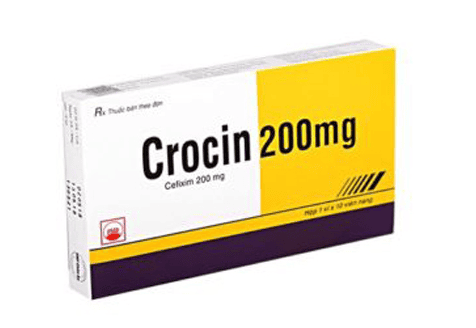This is an automatically translated article.
Aurocefa is a 3rd generation cephalosporin antibiotic, belonging to the group of antifungal, antiviral, anti-infective, anti-parasitic drugs with a broad antibacterial spectrum. The drug has the main ingredient is Cefotaxime and the effect of this active ingredient is to inhibit the synthesis of bacterial cell walls.1. Aurocefa brand-name drug
Aurocefa is a 3rd generation cephalosporin antibiotic, belonging to the group of antifungal, antiviral, anti-infective, anti-parasitic drugs with a broad antibacterial spectrum, with the main ingredient being Cefotaxime (in the form of Sodium Cefotaxime). The drug is produced in the form of a powder for injection, with the content of each vial is 1g.
2. Uses of Aurocefa
Aurocefa has a bactericidal effect by inhibiting bacterial cell wall synthesis. The drug is used to treat severe and critical infections caused by bacteria sensitive to Aurocefa, with the aim of increasing the effectiveness of treatment and avoiding the phenomenon of bacterial drug resistance. Aurocefa is indicated in the following cases: sepsis, brain abscess, pericarditis, infective endocarditis, meningitis (except meningitis caused by Listeria monocytogenes), pneumonia, gonorrhea, typhoid, severe intra-abdominal infections (in combination with metronidazole) and prevention of postoperative infections.Absolutely do not use Aurocefa in patients who are sensitive to any component of the drug or antibiotics of the Cephalosporin and Penicillin groups.
3. Dosage and usage of Aurocefa
3.1. Usage of the drug Aurocefa Aurocefa produced in the form of a powder for injection, is indicated by the doctor for deep intramuscular injection or injection, intravenous infusion. To avoid serious side effects of Aurocefa, intravenous injection should be given slowly, for a minimum of 3 to 5 minutes. For intravenous infusion, administer slowly over 20 to 60 minutes. The vial for injection is mixed with 5ml of distilled water for injection, shaken well to dissolve or mixed into the intravenous solution, the drug is ready to be injected immediately.
Aurocefa drug is used according to the doctor's prescription, so the patient is not allowed to arbitrarily mix and administer the drug at home.
3.2. Dosage of Aurocefa The dose of Aurocefa varies based on the type of susceptible bacteria, the severity of the infection and the patient's condition, so the patient should not increase or decrease the dose of the drug without the prescription of the doctor. doctor.
Adults:
Usual dose: 2-6g/day divided into 2 or 3 times. In severe infections, the dose may be increased to 12 g per day, intravenously divided into 3-6 times a day. The usual dose is ≥ 6g per day, divided into 2-3 divided doses. Do not use more than 12g/day. Treatment of gonorrhea: Use a single dose of 1g. Prophylaxis of postoperative infections: Inject 1g Aurocefa 30 to 90 minutes before surgery. For caesarean section, inject 1g into the mother's vein immediately after clamping the vegetable stalk. After 6 hours and after 12 hours, give 2 more doses intramuscularly or intravenously. Children:
Daily use 100-150mg/kg body weight (for infants, 50mg/kg body weight) divided into 2-4 times. The dose may be increased to 200 mg/kg for severe infections (from 100 to 150 mg/kg for neonates). Patients with renal impairment need to adjust the dose according to Creatinine clearance (CrCl) < 10ml/min t:
After the initial loading dose, reduce the dose by half but keep the number of dosing times per day, the maximum dose for 2g per day.
Duration of treatment: After the patient's body temperature has returned to normal or when the infection is certain that the infection is gone, take Aurocefa for another 3-4 days. For the treatment of infections caused by group A beta-hemolytic streptococci, treatment for at least 10 days is required. Persistent infections, treatment can last for many weeks.
4. Undesirable effects when using Aurocefa
Using Aurocefa may experience some of the following side effects:
Common: Gastrointestinal system (diarrhea), local reactions (thrombophlebitis at the injection site, pain and swelling at the injection site). intramuscular injection site). Uncommon: Blood (eosinophilia or general leukopenia, causing a false-positive Coombs test), digestive system (change in gut flora, possible superinfection by resistant bacteria such as bacilli. green latex, Enterobacter, ...). Rare: Systemic (anaphylaxis, hypersensitivity reactions), Blood (thrombocytopenia, agranulocytosis, anemia, hemolysis), gastrointestinal system (pseudomembranous colitis), liver (elevated) liver enzymes). If the patient needs more information about the drug, he or she can consult a doctor or pharmacist. When using Aurocefa, you may experience some unwanted effects that are not listed above. Therefore, if the patient appears any side effects, it is necessary to notify the doctor immediately for treatment.
5. Notes when using Aurocefa
Patients using Aurocefa should be cautious in the following cases:
Before treatment with Aurocefa, it is necessary to determine the patient's history of hypersensitivity reactions to cephalosporins and derivatives of cephalosporins, penicillins, or other drugs. other. Patients need to inform the doctor who treats their history of allergies to drug groups, to avoid unwanted consequences. When Aurocefa is used concurrently with potentially nephrotoxic drugs (aminoglycosides), clinical symptoms and renal function tests should be monitored regularly. The use of Aurocefa may cause false positives with the Coombs test, urinary tract tests, with reducing agents without the use of enzyme methods. Therefore, it is necessary to evaluate the patient's clinical symptoms in order to accurately assess the disease. Pregnancy: According to several observational studies, Aurocepha did not increase the frequency of malformations or other direct or indirect harmful effects on the fetus. However, it is recommended to use Aurocepha only under the direction of a specialist when absolutely necessary and the benefits outweigh the risks to the fetus. Lactation: Aurocepha is excreted in breast milk. The use of Aurocepha is generally considered to be tolerable in lactating women. However, mothers need to listen to the doctor's advice on dosage before using Aurocepha to avoid drug overdose, monitor symptoms of diarrhea and thrush in babies. Drivers and Machine Operators: The drug can be used by people driving and operating machines.
6. Drug interactions Aurocepha
Aurocepha may interact with the following drug classes. Before using the drug, the patient should inform the doctor about the drugs they are taking for the treatment to be effective and reduce unwanted effects:
Aurocepha and Colistin: Use a combination of cephalosporin antibiotics with colistin (polymyxin antibiotics) may increase the risk of kidney damage. Aurocepha and Ureido-penicillin (azlocillin or mezlocillin): When these drugs are used concurrently, they will decrease the clearance of Aurocepha, reduce efficacy, increase unwanted effects. It is necessary to reduce the dose of Aurocepha. Aurocepha enhances the nephrotoxic effect of the immunosuppressant cyclosporin. Do not mix Aurocepha with alkaline solutions such as sodium bicarbonate. To prepare intravenous solutions, use solutions such as sodium chloride 0.9%, dextrose, ringer lactate or an intravenous solution with a pH of 5-7. Aurocefa should not be mixed with other antibiotics in the same syringe or IV set. Patients are not allowed to change drugs and use drugs on their own, Aurocefa is used under the doctor's prescription and has a medical doctor to carry out the prescription. Above is important information about Aurocefa antibiotic. If you have any questions about Aurocefa, you can contact Vinmec to receive in-depth advice from a team of doctors and pharmacists with many years of experience.
Please dial HOTLINE for more information or register for an appointment HERE. Download MyVinmec app to make appointments faster and to manage your bookings easily.













